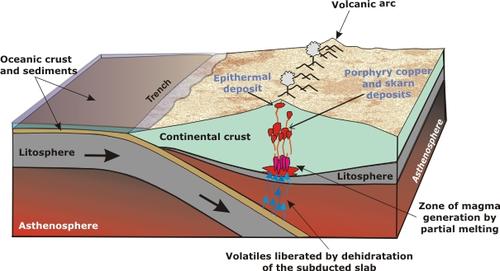Porphyr Copper
Schematic diagram ofthe tectonic setting of porphyry, epithermal and skarn deposits
Image Credit: MBG
Tectonic setting of porphyry copper and epithermal ore deposits
Porphyry copper, skarn and epithermal ore deposits are the most common type of hydrothermal ore deposits. They are genetically linked to convergent tectonic margins characterized by calcalkaline magmatism.
Porphyry copper deposits originate in or nearby porphyritic intrusives which were saturated by water as they intruded in shallow areas of the crust (less than 6 km depth). The developing hydrothermal systems are characterized by the interaction, to different degrees, of fluids coming directly from the parental intrusive and from meteoric surface waters.
Epithermal deposits form at depths of less than 1 km in a hydrothermal system dominated by surface waters with only a small contribution by magmatic fluids.
Skarn deposits form at the contact between intrusive rock and calcareous or clastic rocks which are rich in carbonate. The deposits occur on or near the margins of the intrusions and are the result of replacement of the country rock by hydrothermal fluids carrying high metal concentrations outward from the intrusion. Frequently, the mineralization can be formed by the same fluids which concurrently formed porphyry copper deposits.


